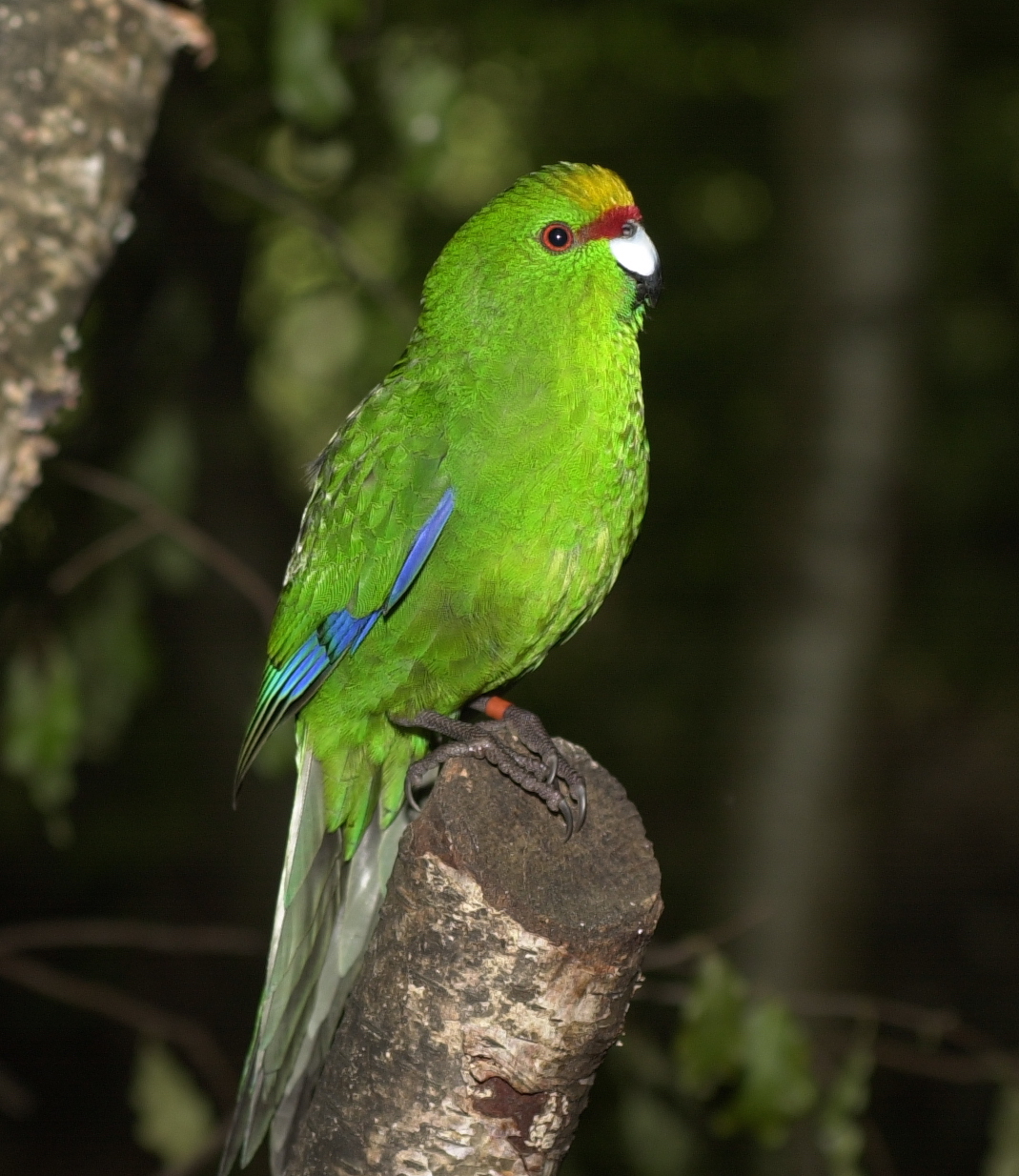karangū
1. (noun) karamū, Coprosma lucida, Coprosma macrocarpa and Coprosma robusta - native shrubs and small trees with pale bark and large leathery glossy leaves. Flowers are greenish white, spindly, in loose clusters and the fruit reddish orange and much sought after by native birds.
I te wā e hua ana te karangū e tangitangi ana ngā manu o te ngahere, "Korokī! Korokā!" (TTR 2000:236). / At the time when the karamū fruits the birds of the forest sing, "Korokī! Korokā!"
See also karamū
Synonyms: karamū, kāramuramu
karamū
1. (noun) karamū, Coprosma lucida, Coprosma macrocarpa and Coprosma robusta - native shrubs and small trees with pale bark and large leathery glossy leaves. Flowers are greenish white, spindly, in loose clusters and the fruit reddish orange and much sought after by native birds.
Ka utaina ngā peka mākū o te whau me te karamū ki runga i te ahi, ko te koromāhu hei rongoā mō ngā poroiwi kua whati (Te Ara 2012). / Wet branches were thrown on a fire with whau and karamū, to make steam as treatment for broken bones.
See also kāramuramu
Synonyms: karangū, patutiketike, kāramuramu
kāramuramu
1. (noun) karamū, Coprosma lucida, Coprosma macrocarpa and Coprosma robusta - native shrubs and small trees with pale bark and large leathery glossy leaves. Flowers are greenish white, spindly, in loose clusters and the fruit reddish orange and much sought after by native birds.
Ko te rākau a te tohunga he kāramuramu hei ā i te ngarongaro rā ki roto i te tōrino (JPS 1894:169). / The wand used by the tohunga to drive the fly into the tōrino is made of kāramuramu wood.
See also karamū
Synonyms: karangū, patutiketike, karamū
raurēkau
1. (noun) manono, kanono, large-leaved coprosma, Coprosma grandifolia - a small native shrub to 6 m tall of lowland forests with pale bark and leathery-large leaves which are olive-green and wavy-edged. Flowers are greenish-white, spindly, in loose clusters. Its reddish orange berries are attractive to birds. The bark is used for producing the yellow colouring when dyeing muka.
2. (noun) rangiora, Brachyglottis repanda - a small tree to 6 m tall with very large, dull green, soft leaves which are white and felted underneath and have wavy edges. Tiny fragrant flowers cover the tree during spring and early summer. Found in both the North and South Islands.
tātaraheke
1. (noun) sand coprosma, Coprosma acerosa - a sprawling, bushy native plant with very narrow, sharp-pointed, yellowish or brownish leaves and pale-blue fruit borne on female plants only. Found on the landward side of coastal sand dunes in coastal Aotearoa/New Zealand.
Synonyms: tarakupenga
2. (noun) bush lawyer, Rubus cissoides, Rubus australis - native plants with hand-shaped, toothed leaves and white, heavily scented flowers. Fruit is yellowish-red, shaped like a small blackberry. The branchlets and backs of the leaf stalks are covered in hooked thorns. Found throughout Aotearoa/New Zealand.
See also tātarāmoa
Synonyms: taramoa, taraheke, tātarāmoa, akatātarāmoa
kanono
1. (noun) manono, kanono, large-leaved coprosma, Coprosma grandifolia - a small native shrub to 6 m tall of lowland forests with pale bark and leathery-large leaves which are olive-green and wavy-edged. Flowers are greenish-white, spindly, in loose clusters. Its reddish orange berries are attractive to birds. The bark is used for producing the yellow colouring when dyeing muka.
manono
1. (noun) kanono, large-leaved coprosma, Coprosma grandifolia - a small native shrub to 6 m tall of lowland forests with pale bark and leathery-large leaves which are olive-green and wavy-edged. Flowers are greenish-white, spindly, in loose clusters. Its reddish orange berries are attractive to birds. The bark is used for producing the yellow colouring when dyeing muka.
raurākau
1. (noun) manono, kanono, large-leaved coprosma, Coprosma grandifolia - a small native shrub to 6 m tall of lowland forests with pale bark and leathery-large leaves which are olive-green and wavy-edged. Flowers are greenish-white, spindly, in loose clusters. Its reddish orange berries are attractive to birds. The bark is used for producing the yellow colouring when dyeing muka.
2. (noun) rangiora, Brachyglottis repanda - a small tree to 6 m tall with very large, dull green, soft leaves which are white and felted underneath and have wavy edges. Tiny fragrant flowers cover the tree during spring and early summer. Found in both the North and South Islands.
tarakupenga
1. (noun) sand coprosma, Coprosma acerosa - sprawling shrub with an intertwined mass of branches and branchlets forming a cushion-like mound up to 2 m across. Branchlets golden brown and small leaves are olive green. Found on coastal sand dunes throughout Aotearoa/New Zealand.
Synonyms: tātaraheke
2. (noun) clubmosses, Lycopodium spp - scrambling or epiphytic plants of various species. Main stems are usually long-creeping, branched and underground. Aerial stems fork repeatedly and are narrow. Small leaves spirally arranged around stem or flattened into one plane.
See also mātukutuku
2. (verb) to be unfinished, incomplete.
I whakarērea e ia tāna mahi, he mea waiho kia hukihuki noa (RTA 2014:92). / He abandoned his task, leaving it unfinished.
3. (modifier) unfinished, incomplete, partial.
Nō tana oranga mai, ka mahi a Pēneti ki raro i a Meiha Tianara Howard Kippenberger i te Puna Kōrero Tuku Iho mō te Pakanga o te Tari Taiwhenua, e tuhi ana i tētehi tuhinga hukihuki mō te hītori o te hokowhitu Māori (TTR 2000). / After his recovery Bennett worked under Major General Howard Kippenberger with the War History Branch of the Department of Internal Affairs writing the draft of the Māori Battalion’s history.
4. (noun) spit for roasting food.
Me tunu tā tātou manu ki te hukihuki (PK 2008:151). / Our bird should be cooked on a spit.
5. (noun) draft, unfinished document, unfinished sample.
Ko te korowai i tukuna e koe, haere hukahuka ana (W 1971:68). / The korowai cloak that you sent came as a sample.
6. (noun) convulsion, spasm, twitch, seizure.
I a ia i te tangihanga mō te pouaru a Hopere, ka pāngia a ia e te hukihuki ohorere (TTR 1996:268). / While attending the funeral of Hopere's widow, he suffered a seizure.
7. (noun) swamp coprosma, Coprosma tenuicaulis - shrub up to 3 m tall with slender spreading branches often interlaced giving a twiggy appearance. Small leaves with a network of veins evident on both sides. Small round drupes are black.
kawariki
1. (noun) large-leaved coprosma, Coprosma grandifolia - a bitter plant that was given to children to make them stronger. Some references say the kawariki is a species of buttercup (Ranunculus spp.).
Koirā a ia i kī ai: 'Māku anō e hanga tōku nei whare. Ko te tāhuhu he hīnau ko ngā poupou he māhoe, patatē. Me whakatupu ki te hua o te rengarenga, me whakapakari ki te hua o te kawariki.' (TTR 1994:134) / That's why he said: 'I myself shall build my house. The ridge-pole will be of hīnau and the supporting posts of māhoe and patatē. Raise the people with the fruit of the rengarenga, strengthen them with the fruits of the kawariki.'
See also kanono
Synonyms: raurēkau, raurākau, manono, patutiketike, kanono, kapukiore
2. (noun) kākāriki, yellow-crowned parakeet, Cyanoramphus auriceps, red-crowned parakeet, Cyanoramphus novaezelandiae - small green native parrots with long tails.
See also kākāriki
Synonyms: kākāriki, porete, torete, tōreterete, pōwhaitere, pōreterete, kākāwaiariki, kākāwariki
3. (noun) green tree gecko and jewelled gecko, Naultinus spp. - green geckos of various species found in low, dense shrubbery.
Synonyms: kākāriki
kapukiore
1. (noun) manono, kanono, large-leaved coprosma, Coprosma grandifolia - a small native shrub to 6 m tall of lowland forests with pale bark and leathery-large leaves which are olive-green and wavy-edged. Flowers are greenish-white, spindly, in loose clusters. Its reddish orange berries are attractive to birds. The bark is used for producing the yellow colouring when dyeing muka.
patutiketike
1. (noun) manono, kanono, large-leaved coprosma, Coprosma grandifolia - a small native shrub to 6 m tall of lowland forests with pale bark and leathery-large leaves which are olive-green and wavy-edged. Flowers are greenish-white, spindly, in loose clusters. Its reddish orange berries are attractive to birds. The bark is used for producing the yellow colouring when dyeing muka.
2. (noun) karamū, shining karamū, Coprosma lucida - tall native shrub with green stems and glossy green pairs of leaves. Leaves 12-17cm long, oval, tapering to leaf stem and tip, main vein pale and causing a ridge on the upper and lower surface of leaf. Small colourless point on stem between bases of leaf pairs. Fruit red, in clusters.
See also karamū
Synonyms: karangū, karamū, kāramuramu
2. (modifier) curly, twisted (especially of the grain of timber, hair, etc.).
E mea ana a Te Hokena ko te Merenīhia he potopoto, he mangu, he māhunga mingimingi, he pukukino, he kūare, tēnā ko ngā Māori e noho tahi ana rātou he roroa, he ngāwari, he takahoahoa, he kiri mā - ko ētahi rite tonu ki te Pākehā te mā (TP 1/1909:4). / Mr Hogan reports that the Melanesians are shortish, black, have curly hair, are volatile and uneducated, whereas the Māori that they are living with are tall, gentle, friendly and fair-skinned - some are as white as the Pākehā.
3. (noun) broad-leaved mingimingi, Leucopogon fasciculatus, Coprosma propinqua var. propinqua and prickly mingimingi, Leptecophylla juniperina subsp. juniperina - native shrubs with small, narrow leaves which alternate or are in tufts, prickly to touch. Fruit is red, pink, blue or white and the bark is black.
Synonyms: pātōtara, ngohungohu, mikimiki, mingi, tūmingi, hukihukiraho, taumingi, miki, inangapōriro
hūpirau-ririki
1. (noun) stinkwood, Coprosma foetidissima - shrub or tree up to 6 m tall with narrow to broadly ovate leaves which smell of rotten eggs when crushed. Drupes yellow to orange.
See also hūpiro
pipiro
1. (noun) stinkwood, Coprosma foetidissima - shrub or tree up to 6 m tall with narrow to broadly ovate leaves which smell of rotten eggs when crushed. Drupes yellow to orange.
See also hūpiro
mingi
1. (verb) be curly, twisted (especially of the grain of timber, hair, etc.).
Ko tētahi tū, he uru pākākā, he taranui te huruhuru o te upoko, arā, he ahua mārō; he āhua māwhatu, he mingi ētahi (JPS 1913:177). / Another kind had reddish-brown hair, and thick hair, that is it was somewhat straight while others had somewhat curly locks or close curls.
2. (noun) broad-leaved mingimingi, Leucopogon fasciculatus, Coprosma propinqua var. propinqua and prickly mingimingi, Leptecophylla juniperina - native shrubs with small, narrow leaves which alternate or are in tufts, prickly to touch. Fruit is red, pink, blue or white and the bark is black.
Synonyms: mikimiki, mingimingi, hukihukiraho, tūmingi, ngohungohu, inangapōriro, taumingi, miki
taupata
1. (noun) taupata, Coprosma repens - a large native shrub or low creeper-like plant with very glossy leaves, often rolled under at the edges. Found on cliffs and sand dunes of the North Island and the northern South Island. Fruit bright orange and borne only on female plants from summer to autumn.


